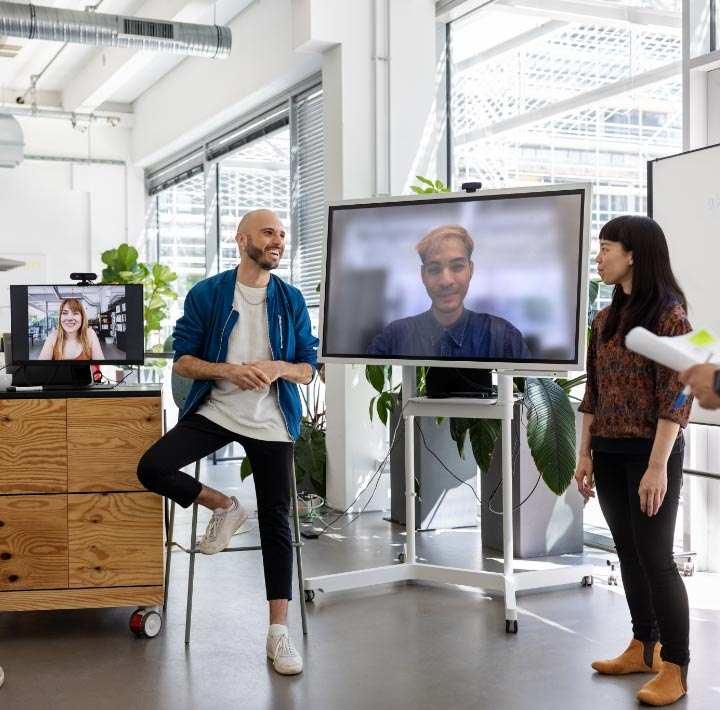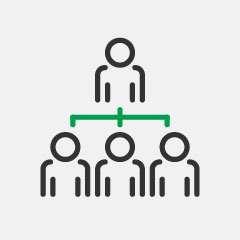
A Guide to Hybrid Work and Managing a Remote Team
- What is hybrid work, and how is it different from remote work?
- Why are hybrid workplace models the future of work?
- What are the advantages of employing remote workers?
- What are the best remote jobs?
- How do you manage and keep remote teams engaged?
- How to maintain a positive remote work culture
- How to prepare your business for long-term remote working
- How can we make the hybrid work model successful?
01 What is hybrid work and how is it different from remote work?
Hybrid work is work that's done both in the office and outside the office. While remote work is always based outside the office (and maybe even thousands of miles from it), the hybrid work model combines working from home and working at the office.
Hybrid work schedules can vary drastically, from being in the office occasionally to coming in four times a week. Depending on your organization, this can be an advantage or a challenge of the hybrid schedule.

02 Why are hybrid workplace models the future of work?
Many factors point to a hybrid work model as the future of work. But none are more important than this: Six in 10 U.S. employees with remote-capable jobs want a hybrid work arrangement. About one-third prefer fully remote work, and less than 10% prefer to work on-site.
Many employers may be left fearful of hybrid work leading to a disjointed culture or lost engagement. The data tell a different story. In fact, exclusively remote and hybrid employees tend to have significantly higher employee engagement than on-site workers.
The demand alone is enough for businesses -- especially those that have roles that don't require the context of an office environment -- to seriously consider offering either fully remote or hybrid work going forward.
Why do employees want a hybrid arrangement?
Hybrid employees feel strongly about the advantages of their work arrangement -- the top benefits of hybrid work are selected two to three times more than the top challenges.
A hybrid office can empower employees to develop a better work-life balance, giving them control over their time management and wellbeing. Having the option to go into the office can help employees be more productive and feel more connected with their team and organization.

03 What are the advantages of employing remote workers?
Hiring remote workers doesn't only lead to real estate and overhead savings for organizations. It can also provide:
1. An Expanded Remote Hiring Pool The ability to work from home can expand an organization's hiring pool from local to national or international talent, with relocation no longer a requirement.
2. High-Talent Job Candidates A more remote and flexible work culture can be a powerful tactic for attracting and engaging top talent -- turning what used to be workplace perks into requirements for securing quality hires.
3. Talent Retention Remote work can benefit the employee experience. Employees value flexibility in the workplace, including flextime and remote work. And a wide talent pool means competition for talent is only increasing.
4. Organic Improvements in Employee Performance Remote teams working in the right role with the right support can significantly outshine on-site workers.
Remote work isn't just better for business -- it's better for employees too. Remote employees often have higher engagement and wellbeing than fully on-site workers who can do at least portions of their job remotely.
When employees are required to work fully on-site but prefer a hybrid or fully remote work arrangement, they experience:
Gallup asked workers if they would look for a new job if their employer stopped offering remote work options, and 64% of employees currently working exclusively from home said they would likely look for another job; 29% of hybrid workers said the same.
Potential Drawbacks of Remote Work
For all the advantages remote work offers, the tradeoff is that it fundamentally changes how employees interact with and experience your organization. And when managed poorly, remote work can dramatically erode engagement and productivity.

- Performance
- Engagement
- Culture
- Brand
- Customer relationships
With a thoughtful blueprint and clear expectations, remote work can help your employees and organization thrive.
04 What are the best remote jobs?
When a job is a good fit for remote work, engagement climbs and burnout declines as the amount of time employees work remotely increases.
A recent Gallup study shows that engagement is highest among hybrid workers -- and lowest for fully on-site workers. Similarly, remote workers report lower levels of burnout, while fully on-site employees have the highest levels of burnout.

Why is that important? When employees are engaged and have high wellbeing, they are:
- more likely to report excellent performance in their role
- more likely to report high levels of adaptability
- more likely to recover fully after illness or injury
- less likely to look for another job with a different organization in the next 12 months
But don't assume all roles transition well to remote work. Leaders should evaluate each job's suitability for remote work by analyzing job demands and factors that affect productivity.
Three Criteria to Use When Evaluating Positions for Remote Work
Examining our extensive databases, Gallup found that an optimal remote work role meets three criteria:

Remote employees can perform their duties away from an on-site work environment. The starting point for evaluating if a role is remote work capable is to consider whether employees can do the job outside the traditional office setting.

Most of the role's tasks and processes are inherently well-defined. Well-defined tasks and processes have clear timelines, expectations and measures of evaluation.

The success of the role does not depend on highly interdependent work. Highly interdependent work requires more than simple communication and collaboration. It requires simultaneous or synchronized input from multiple partners to complete tasks and move a project forward.
These criteria don't guarantee success or failure. But Gallup's analysis of remote worker engagement and burnout shows that roles that do not meet all three criteria will likely require additional support from the manager and organization to produce exceptional performance in a remote work setting.
Each Organization Requires Unique Remote Work Policies

Leaders can consider many objective factors when determining which roles employees can perform remotely.
However, just because a role meets the criteria above doesn't necessarily mean that making it a remote work role is right for your business. The most important consideration should be whether it's good for your people and your organization.
To ensure your work-from-home strategy is effective, Gallup can assess and analyze the experiences and needs of employees in various roles in your organization.
05 How do you manage and keep remote teams engaged?
Remote and on-site teams need the same things from their manager to be successful -- but remote workforce management can look much different.
Employee engagement -- employees' involvement in and enthusiasm for their work and workplace -- should be a manager's primary focus. That's because the manager alone determines 70% of the variance in team engagement.

When strategizing how to engage remote employees, review the basic drivers of employee engagement through the lens of remote work.
1. Purpose
Why does it matter? When managers connect and communicate purpose with their team, it attaches meaning to the work employees do. It's easier for employees to see how their work fits into the big picture when their manager points them toward the larger goals.
What does it mean for managers of remote workers? Don't let your remote employees fall into a rut. Give employees a wider perspective of your company's purpose and show them how their work fits in. That purpose will help connect them to their team and your organization.
2. Development
Why does it matter? Gallup data show that lack of development and career growth is one of the top reasons employees leave a job. Employees expect to be developed when you hire them.
What does it mean for managers of remote workers? Don't let remote workers be "out of sight, out of mind." Developing remote employees might require a different strategy than developing on-site employees, but it should remain a high priority for managers.
3. A Caring Manager
Why does it matter? Employees need to know that they are more than just a number. They need to know that someone is concerned about them as people first and as employees second.
What does it mean for managers of remote workers? Take time to intentionally connect with your remote employees through Quick connects, Check-ins and Developmental Coaching -- meetings that might happen naturally in the office.
4. A Focus on Strengths
Why does it matter? When managers remove roadblocks and focus on helping employees do what they do best every day, employee wellbeing increases, and so does their organization's employee attraction, engagement and retention.
What does it mean for managers of remote workers? Weave strengths into your conversations and activities with remote employees. Strengths conversations motivate and empower employees -- they help them better understand themselves and others, create bonds, and develop relationships.
Communication Is Key
Communication is an integral part of employee engagement. But Gallup research finds that communication is poor across the board:
27% A staggering 27% of U.S. workers strongly agree that their immediate supervisor keeps them informed about what is going on in their organization.
20%Only 20% of employees strongly agree that they have received meaningful feedback in the last week.
These data emphasize the need for clear, purposeful and frequent contact with remote employees. Make sure remote employees feel connected. Weave the three basics of communication -- accuracy, openness and timeliness -- into your remote employee management strategy.
06 How to maintain a positive remote work culture
Decisions that affect the employee experience reflect your organizational culture. These decisions can leave employees, customers, investors and communities with a lasting impression of your organization's reputation.
If you're not thinking about how to impart that culture to your remote employees, you're at risk of falling behind.

- Consistency Does our decision convey our company culture?
- ClarityIs there a hidden or unclear agenda behind the decision?
- AuthenticityIs our rationale credible?
Impart and Sustain Company Culture for Remote Employees
Think about how you implement these culture drivers in your remote and hybrid workplace strategy.

Leadership and Communication
How will you communicate your company's purpose with your remote employees? Make a plan for how that purpose will influence and support them.

Values and Rituals
Find ways to effectively include remote employees in your company rituals. Weave your company values into your one-on-one conversations, meetings and remote team building activities.

Work and Team Structure
Consider how your team's structures influence how remote employees experience your organization. Make sure your organizational structure reflects your purpose.

Performance and Recognition
Provide frequent and meaningful recognition for remote employees. Ensure expectations and goals are clearly defined and achievable.
Culture is the key to employee performance and customer engagement. Ensure that your remote employees are as in tune with your organizational culture as those in the office.
07 How to prepare your business for long-term remote working
Organizations need a clear long-term remote work strategy to create a competitive advantage while supporting employees' wellbeing.
Build your remote work best practices based on:
- research about the optimal structure for remote work
- a careful review of your organization's job families, considering the unique responsibilities that may differentiate seemingly similar roles
- the evaluation of individuals' fit for long-term remote work, taking into consideration their role, team and individual needs

Create a Plan for Transitioning to Long-Term Remote Work
Once your organization has a well-informed strategy defining which roles can and should be performed remotely and the degree to which people will work from home, leaders must create a targeted plan for transitioning to a long-term remote work approach.
Your transition plan should provide the necessary remote work policies, structure and support to be successful.
Before acting on your work-from-home strategies, ask the following questions:
- What conditions are necessary for success in the off-site work environment?
- Do employees have the tools and equipment they need to perform their best while working remotely?
- Have managers clearly defined and communicated employees' expectations?
- What tools and training foster critical ongoing conversations between managers and remote employees?
- What essential employee experiences should managers assure their remote workers have in order to have a strong sense of culture and belonging?
Questions like these are just a start. Consider your organization's unique characteristics and ideal remote work situation when preparing your remote work strategy.
08 How can we make the hybrid work model successful?
Finding the right balance between on-site and off-site work can be tough. It requires an individualized approach -- recognizing that what works for one employee might not work for another.
Here are four employee needs to think about when crafting your hybrid work model best practices:
1. Engagement and Wellbeing
Why does it matter? Our research has shown that engagement and wellbeing are reciprocal -- each influence the state of the other. They are also additive -- each makes a complimentary contribution to the thoughts, feelings, behaviors and performance outcomes of employees. What does it mean for the hybrid work environment? Gallup data show that engagement and wellbeing are frequently higher for fully remote and hybrid employees. How should leaders respond? Stay in tune with hybrid and remote workers through increased communication and listening.

2. Fairness and Inclusion
Why does it matter? Hybrid and remote workers can feel isolated or left out of important conversations, leading to disengagement and dissatisfaction.What does it mean for the hybrid work environment? Hybrid and remote employees report receiving less weekly feedback than on-site workers. When employees receive feedback more frequently, they are most likely to be engaged and deliver great performance. How should leaders respond? Consider who may be feeling left out, and intentionally plan to have regular conversations with each member of your team.

3. Trust and Productivity
Why does it matter? Managers and leaders need to know that their remote and hybrid employees are delivering quality and timely work. What does it mean for the hybrid work environment? Hybrid and remote work require moving away from micromanaging and passive managing. How should leaders respond? Develop and hire managers who can be true developmental coaches. Find more value in productivity metrics and behaviors than in how busy (or not busy) employees seem.

4. Relationships and Culture
Why does it matter? A strong culture creates alignment and builds engaged teams. What does it mean for the hybrid work environment? The physical distance between employees can hinder building relationships and establishing culture. How should leaders respond? Ask managers to set expectations and policies with the team's input and intentionally design team activities with in-person and remote team members in mind.

Creating an individualized employee strategy will take time and effort. Leaders and managers need to be aligned on their strategies to ensure success across the board.
How Gallup Can Help
We can help you analyze your organization's workforce and provide ongoing monitoring and expert insights and advice that reflect how your people are experiencing the new workplace.
Gallup can help your organization:
- craft a work-from-home strategy informed by our extensive database and analysis to build a resilient culture
- train managers to coach, develop and lead remote workers effectively
- design a remote onboarding experience to prepare for and address the needs of remote teams
- provide strengths-based development for individual contributors and teams to enable optimal remote work
- refine your talent acquisition strategy to build your remote workforce for the future
Succeed With Remote Work
Partner with Gallup to explore next steps for developing your organization's work-from-home and other workplace strategies.